Abstract
Background: The growing demand for fresh food leads to extensive use of cold chain logistics (CCL) that significantly contributes to greenhouse gas (GHG) emissions due to its dependence on energy-intensive transport refrigeration units (TRUs). Understanding the need to balance food preservation with environmental sustainability, this paper explores practical strategies for reducing GHG emissions in CCL, focusing on fresh food products. Methods: The quantitative and qualitative analyses are applied to analyse data from Transport for London and Transport Scotland. Emission data were assessed to evaluate the impact of alternative TRU technologies and route optimisation practices. Results: The findings reveal that electric and cryogenic TRUs, along with improved route planning and operational practices, can significantly reduce the emissions of carbon dioxide, nitrogen oxides and particulate matter. These results highlight the potential strategy for industry-led emission reductions without compromising food quality. Conclusions: This paper recommends the coordination of government policy and industry to support technological adaptation and infrastructure upgrades and to research into real-time monitoring and renewable energy integration in CCL systems.
1. Introduction
The importance of transport refrigerated units (TRUs) in CCL has increased significantly due to the rapid expansion of global trade and the increase in consumer demand for fresh food products. From farm to table, these systems are crucial for preserving the safety and quality of perishable commodities which need specific temperature ranges to avoid spoiling. However, this energy-intensive CCL has significant environmental impacts. Wang et al. [1] indicated that CCL was responsible for the food supply chain’s overall carbon emissions, underscoring the industry’s substantial environmental effect. The primary drivers of carbon footprint from these logistics systems are transportation and refrigeration needs, consuming a lot of energy and increasing GHG emissions [2,3].
To address these environmental issues, it is necessary to investigate the rationale of green logistic strategies for TRUs. In some instances, technological constraints of CCL cause difficulty in implementing more energy-efficient systems [4]. High initial costs of installing new technologies into the current infrastructure cause significant challenges to CCL [5]. In addition, the absence of consistent legislation and standards across many locations complicates efforts to apply sustainable practices globally [6]. A thorough examination of existing methods is required to address these issues and achieve sustainable solutions in CCL [7].
This paper focuses on global environmental sustainability and the pressing necessity to alleviate the effects of climate change. The logistics sector, especially CCL, is vital to the world economy yet notably contributes to GHG emissions [2]. The pressing nature of climate change and the substantial impact of effective logistics on diminishing the carbon footprint of fresh agricultural products render this a vital subject of interest for both scholars and industry professionals [5]. Moreover, there is increasing acknowledgment among policymakers, business leaders and consumers regarding the necessity of sustainable logistics techniques [8]. This heightened awareness fosters a climate receptive to the adoption of green logistics solutions. In addition to evaluating the benefits and drawbacks of current methods, this paper identifies the fundamental components of the industry’s GHG emissions and investigates novel approaches that can be applied in practical settings.
This paper addresses a research question. How can greenhouse gas emissions from CCL be effectively reduced through real-world operational changes and technological adaptation without compromising food quality? Answering this research question, this paper identifies the primary contributors to GHG emissions in cold chain logistics, evaluates the effectiveness of low-emission TRU technologies and logistics strategies and proposes practical and context-specific solutions for emissions reduction in both urban and rural settings. This paper applies a mixed-methods case study approach, using data from Transport for London and Transport Scotland to represent different geographical and regulatory contexts. The regression and Monte Carlo simulations analyse the emissions data to evaluate the effects of alternative TRU technologies and operational practices.
The primary contribution of this paper lies in connecting theoretical GHG-reduction strategies with empirical findings from actual logistics environments, producing actionable insights for both policymakers and industry stakeholders. This paper offers insights that can support sustainable technology adoption, behavioural interventions and regulatory planning in CCL. It also contributes to the literature by conducting a simulation-informed comparative analysis of cold chain logistics in two distinct UK regions—London and Scotland—using secondary emissions data, policy documents and operational reports. The relevance of such practical and data-informed strategies is increasingly recognised by scholars and the industry alike [5,8,9].
This paper is organised in six sections. The Introduction Section is followed by the literature review section on CCL, focusing on key factors contributing to GHG emissions and the effectiveness of current green practices to identify the research gap in CCL. The Methodology Section describes the rationale of selected data collection and analysis methods. The methodology section is followed by Results, Discussion and Recommendations, and Conclusions.
2. Related Studies
The literature review focuses on the environmental impact of TRUs, alternative technologies and green logistics strategies in CCL. To strengthen the conceptual foundation of this study and address the structural gap identified in the literature review, a comprehensive literature matrix was created (Table 1). This matrix summarises key studies in the cold chain logistics (CCL) domain, highlighting their research goals, methods, findings, practical applications and directions for future work, ensuring the systematic organisation and comparison of relevant studies [10]. The matrix clarifies the academic trajectory that informs the present study and outlines the methodological and thematic gaps it seeks to address.
Several studies developed new models and algorithms to optimise routes, reduce costs and lower emissions. For instance, Yao et al. [11] used an Ant-Colony Optimisation (IACO) algorithm to solve vehicle-routing problems (VRPs) while reducing emissions and improving freshness-keeping measures. These methods showed that considering carbon emissions and real-time traffic could make logistics greener and more cost-effective [12]. Bin et al. [13] highlighted the importance of freshness-keeping investments, while Shashi et al. [14] focused on the role of Radio Frequency Identification (RFID) technologies. In addition, Shi et al. [15] demonstrated the added value of integrating real-time data to manage CCL.
While the literature matrix in Table 1 provides individual-level insights, synthesising these works reveals recurring research constructs relevant to our analysis. Table 2 presents a cross-study mapping of key constructs that inform our case studies. Table 2 summarises research gaps in CCL. Most studies assumed constant vehicle speeds and focused on single distribution centres and vehicle type, limiting real-world applicability [11,16]. They often neglected the impact of varying traffic conditions [12] and multiple product types or logistical setups [13]. In addition, integration of new technologies like IoT and 5G [17] and the exploration of collaborative strategies among companies [14] were not thoroughly examined. Future research should address these gaps by incorporating diverse real-world conditions, advanced technologies and broader logistics networks to create more robust and adaptable CCL. However, much of the current literature relies on simulations or models that do not fully reflect real-world complexity, such as variable traffic, multi-product loads and inconsistent regional policies. There is a notable lack of empirical research based on operational case studies that compare urban and rural contexts using existing infrastructure.
In summary, this section highlights several recurring constructs in CCL research, such as the technological effectiveness of TRUs (e.g., electric and cryogenic systems), operational strategies such as route optimisation and emissions tracking, and regulatory or cost-related factors influencing adoption. However, most prior studies are model-based and focused on isolated environments, lacking comparative and real-world evidence across regions. This paper conducted a case study analysis aiming to bridge theoretical models with practical applications.

Table 1.
Literature review matrix.
Table 1.
Literature review matrix.
| Study | Goal | Methods | Findings | Research Prospects | Practical Applications |
|---|---|---|---|---|---|
| Yao et al. [11] | Green VRP focusing on carbon emission | IACO algorithm and VRP model used for simulating cold chain logistics operations in China | An increased carbon tax reduced carbon emissions but increased costs. Investment in freshness-keeping reduced both costs and emissions, thereby improving customer satisfaction. Green distribution strategies and appropriate carbon tax policies can help in the reduction in emissions and enhance economic benefits. | Investigate VRP with different vehicle types and distribution centres, validate model parameters and explore other heuristic algorithms and deep learning approaches | Invest in freshness-keeping measures and consider carbon tax impacts to balance environmental and economic factors when setting carbon tax levels |
| Ning et al. [16] | Optimisation of cold chain distribution path under carbon tax mechanism | Quantum Bacterial Foraging Optimisation (QBFO) algorithm for simulations for CCL operations in China, focusing on 13 supermarket stores | The QBFO algorithm effectively optimised the distribution path, lowering both carbon tax and comprehensive cost. The QBFO algorithm outperformed classical algorithms in terms of convergence speed and optimisation capability. The shortest distribution path does not quite minimise carbon tax and comprehensive costs. | Explore the impact of unknown and uncertain interference events, such as traffic congestion and vehicle failure, on overall costs and carbon tax costs | Strategies to minimise carbon emissions and comprehensive costs by optimising distribution paths; focus on impact of carbon tax mechanisms on logistics operations |
| Ji et al. [18] | Robust optimisation (RO) approach to two-echelon agricultural CCL, considering carbon emission and stochastic demand | Linear Programming (LP) model and three RO models (R-box, R-polyhedron, R-ellipsoid) used to analyse operational records of CCL company in Yangtze River Delta, China | The RO models can solve uncertainty problems while maintaining robustness. The R-ellipsoid model provided the best results, showing improved cost and environmental benefits with enhanced carbon tax. The RO models overcome the limitations of the LP model in handling uncertainty, demonstrating their effectiveness and robustness. | Explore application of RO models in different scenarios of logistics, including use of advanced technologies like IoT and 5G to further improve robustness and efficiency | Adopt RO models to manage uncertainties and optimise distribution paths. Consider increasing carbon taxes to encourage more efficient and environmentally friendly logistics practices |
| Bin et al. [13] | Selection of cold chain logistics model based on carbon footprint of fruits and vegetables in China | Life cycle assessment to calculate carbon emissions at each step of cold chain; empirical analysis based on energy balance equations to study refrigerated transportation methods at different transport times | The emission of 0.098 kg of CO2 from 1 kg of fruits and vegetables, of which 82% from transportation. Pre-cooled fruits and vegetables transported within 5 h should use insulated transport. Cold storage transport is preferable for products with transportation times between 5 and 60 h. For longer times, mechanical refrigeration is quite efficient. Emissions from small and refrigerated trucks are three times greater than for heavy trucks. Increased insulation-layer thickness can lower emissions. | Explore advanced refrigeration technologies with higher coefficient of performance, refrigerants and optimisation models, including real-time data and IoT | Select transport methods based on transportation time and improved insulation layers; support development of high-efficiency refrigeration technologies and standards for carbon emissions in CCL |
| Bai et al. [12] | Low-carbon VRP for CCL including real-time traffic conditions | Nondominated Sorting Genetic Algorithm II (NSGA-II) to solve optimisation model and obtain Pareto frontal solution set for distribution cost and carbon emission | The inclusion of real-time traffic data in routing models can largely reduce carbon emissions and distribution costs for CCL compared to traditional models. | Explore multi-type vehicle routing and multi-distribution centres with real-time data and advanced IoT technologies | Routing strategies including real-time traffic optimise efficiency, reduce emissions and support low-carbon logistics initiatives |
| Shi et al. [15] | Intelligent green scheduling system for sustainable CCL (IGSS-CCL) | Two-stage optimisation algorithm based on Dijkstra’s algorithm and NSGA-III for performance analysis | The study effectively combines resources for optimal scheduling, reducing costs, carbon emissions and the number of vehicles used. Multi-objective optimisation in IGSS-CCL promotes resource savings, environmental protection and sustainable development. IGSS-CCL outperformed traditional single-objective optimisation methods. | Explore advanced algorithms for multi-objective optimisation combined with real-time data for different logistics scenarios | IGSS-CCL can be used as decision-support tool to control and supervise scheduling operations |
| Aikins and Ramanathan [19] | Carbon footprint factors in UK’s food supply chains | Secondary data from ONS and FAOSTAT (1990–2014) analysed using Multilinear Regression (MLR) and Stochastic Frontier Analysis (SFA) to identify factors contributing to CO2 emissions in UK’s food supply chains | Transportation and Sales/Distribution are key factors in CO2 emissions. Efficient processes in UK logistics contribute to lower CO2 emissions. | Sustainability Impact Assessment of UK food supply chain focusing on social, economic, regulatory and environmental impacts using all-inclusive LCA tool | Adopt low-carbon practices and renewable energy, and improve efficiency in logistics operations |
| Shashi et al. [14] | Challenges and merits of food cold chain management | Bibliometric analysis and network analysis of 1189 food cold chain articles published in last 25 years using descriptive statistics and science mapping approach using VOSviewer online software. | The study identified the top contributing and influential countries, authors, institutions and articles in food cold chain research using the application of RFID technologies, production and operation planning models, postharvest waste causes, inventory ordering policies and critical issues. It identified key areas for future investigation and offered a roadmap for further research to yield practical and modelling insights. | Focus on sustainability impact assessments integrating advanced technologies and comprehensive approaches to food cold chain management | Harness insights from food cold chain research to improve strategic and tactical decision-making, sustainability and efficient food supply chain management |

Table 2.
Cross-study mapping of key constructs in cold chain logistics research.
Table 2.
Cross-study mapping of key constructs in cold chain logistics research.
| Study | TRU Technology | Route Optimisation | Emissions Metrics | Operational Behaviour | Policy/Cost Factors |
|---|---|---|---|---|---|
| Yao et al. [11] | ✖️ | ✅ | ✅ | ✖️ | ✅ |
| Ning et al. [16] | ✖️ | ✅ | ✅ | ✖️ | ✅ |
| Shi et al. [15] | ✅ | ✖️ | ✅ | ✅ | ✖️ |
| Bai et al. [12] | ✖️ | ✅ | ✅ | ✅ | ✖️ |
| Bin et al. [13] | ✅ | ✖️ | ✅ | ✖️ | ✖️ |
| Aikins & Ramanathan [18] | ✖️ | ✖️ | ✅ | ✖️ | ✅ |
Note: “✅” = Covered by the Study; “✖️” = Not Covered.
3. Methodology
This study adopts a pragmatic research philosophy aiming to connect theoretical insights with real-world practices for reducing emissions in CCL [19,20]. A multiple-case-study design was chosen to explore how different geographical, economic and policy environments shape GHG emission outcomes and logistics strategies in the UK. Case studies are particularly suited to this research, as they allow for an in-depth understanding of complex and context-specific phenomena such as TRU emissions, operational behaviours and regulatory responses [21]. Monte Carlo simulations and time-series models were used to explore emission scenarios and operational variability, building on established approaches in logistics and environmental modelling [14,17]. While the findings are based on secondary data and not statistically generalisable, the case-based approach provides analytical depth and supports the development of practical and region-specific recommendations [22,23].
The two case studies were chosen to represent contrasting logistics and environmental conditions within the UK. London represents a highly urbanised setting with strict environmental regulations, while Scotland represents a semi-rural context with strong regional investment in green logistics [24]. The dual-case design supports comparative analysis of technology adoption and emission reduction strategies in varied logistical environments. Data were extracted from Transport for London (TfL) reports on TRU emissions in the Greater London Area [25], Zemo Partnership emissions testing reports commissioned by Transport Scotland [23] and Scottish Government policy briefings on climate planning and infrastructure investments [24]. These documents provided emission metrics (e.g., CO2, NOx, PM), operational statistics (e.g., vehicle hours, fuel consumption, door-open times) and cost projections for technology upgrades.
While case studies provide rich contextual insights, they have limitations. The findings may not be broadly generalisable and are influenced by the availability and scope of existing secondary data. Nonetheless, the method is appropriate for investigating region-specific applications of emerging technologies and operational strategies in CCL.
4. Results
4.1. Transport for London
London’s CCL operates under strict environmental controls and dense delivery networks. TfL investigated diesel-powered TRUs and trialled alternatives such as liquid nitrogen systems. The region’s high volume of refrigerated deliveries and exemption of small TRUs (<19 kW) from Euro VI standards presents a significant emissions challenge [22]. Of the 25,500 temperature-controlled vehicles in London, 3500 use diesel-powered TRUs, with 71% operating multi-temperature compartments. Despite new technologies, most of these units fall below regulatory thresholds, allowing continued emissions. Alternative TRUs such as cryogenic systems demonstrated significant reductions in CO2 emissions by up to 80% and NOx and PM emissions by up to 100%. These results confirmed the findings of Bai et al. [12], who demonstrated the environmental benefits of integrating alternative TRUs into urban logistics under real-world traffic conditions. Figure 1 shows the trend analysis of emission reduction from alternative TRU technologies.
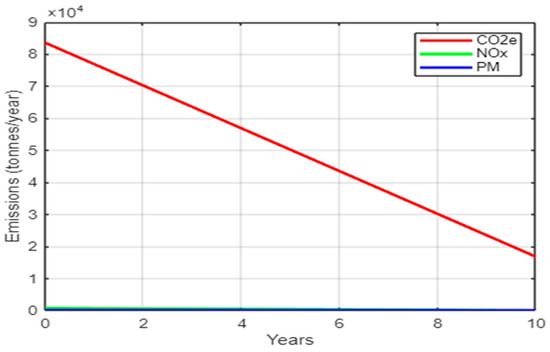
Figure 1.
Trend analysis of emission reduction from alternative TRU adoption.
Monte Carlo simulations (Figure 2a,b) were used to model probabilistic variation in NOx and PM emissions from TRUs under operational conditions. These simulations provide insight into variability caused by ambient temperature, vehicle load and idling patterns following the analytical method applied by Ji et al. [17] to evaluate emission uncertainty. A regression analysis was conducted to compare the Euro VI standards and the non-road mobile machinery (NRMM) Stage V standards (Figure 3). Figure 3 shows that the NRMM Stage V engines that are primarily used in TRUs emit significantly higher levels of NOx and PM compared to Euro VI engines, with up to 16 times more NOx and 40 times more PM, respectively. The Euro VI standards for on-road vehicles significantly reduced emissions. On the contrary, NRMM regulation lag results in significantly high emission levels from off-road equipment including TRUs [18]. These higher emission levels, particularly from diesel-powered refrigeration units, contribute most of CCL’s emissions. This supports findings from Aikins and Ramanathan [18] that regulation gaps in off-road logistics machinery led to disproportionate emissions in urban settings.
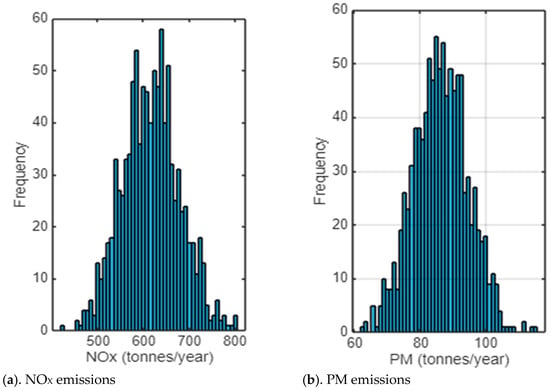
Figure 2.
Monte Carlo simulation of emissions from operating vehicles.
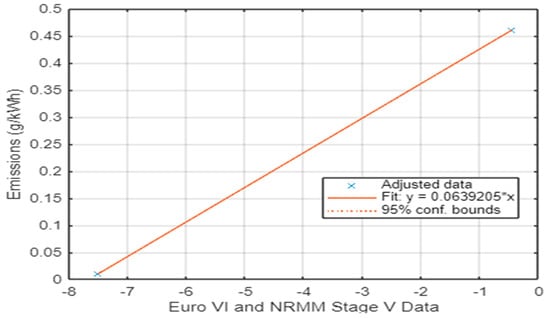
Figure 3.
Euro VI vs. NRMM Stage V Standards.
The time-series analysis in Figure 4 indicates that transitioning to light-coloured refrigerated bodies can result in an annual reduction of 2000 tons of CO2 over a decade due to the lower heat absorption of lighter hues. This result is consistent with research on temperature management in refrigerated trucks [24]. Oliveto et al. [24] indicated that light-coloured surfaces reflected a greater amount of solar energy, hence decreasing cooling demand by roughly 10–20%. This directly links to energy conservation and diminished CO2 emissions due to the decreased burden on refrigeration systems. Time-series analysis of NOx emissions observes a 5% annual reduction for low-emission vehicles (LEVs) using optimised routes (Figure 5). Over 10 years, this leads to large cumulative reductions in NOx emissions. Bai et al. [12] argued that optimising routes for LEVs by considering real-time traffic conditions significantly reduced both NOx emissions and distribution costs, highlighting the environmental benefits of optimised routes for greener technologies in urban logistics. Route optimisation for LEVs has also been demonstrated to encourage fleet operators to adopt greener technologies, amplifying the environmental benefits.
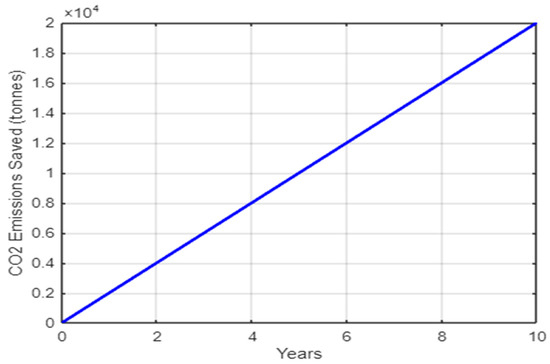
Figure 4.
CO2 savings over time from light-coloured refrigerated bodies in London.
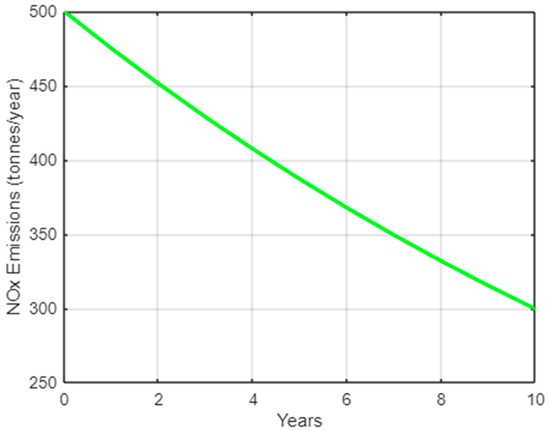
Figure 5.
NOx emission reduction over time with preferential routes for LEVs in London.
4.2. Transport Scotland
Scotland’s logistics network includes long-haul routes across rural and regional areas. The Zemo Partnership, supported by Transport Scotland, assessed emissions from diesel-powered auxiliary TRUs (auxTRUs) and evaluated the upgrade strategies under real-world seasonal conditions [25]. Emissions testing was conducted on semi-trailers and small HGVs during summer and winter operations, with TRUs running for 1500–4200 h annually. The results (Figure 6) show a 20% annual decrease in NOx emissions, falling from 45 g/h to approximately 8 g/h over ten years. These annual reductions are consistent with Shi et al.’s [15] findings, claiming major environmental gains across NOx, PM and CO2 emissions when transitioning from diesel to electric TRUs. Monte Carlo simulations (Figure 7) captured the variability in adoption scenarios, reinforcing the use of stochastic modelling as employed by Ji et al. [17].
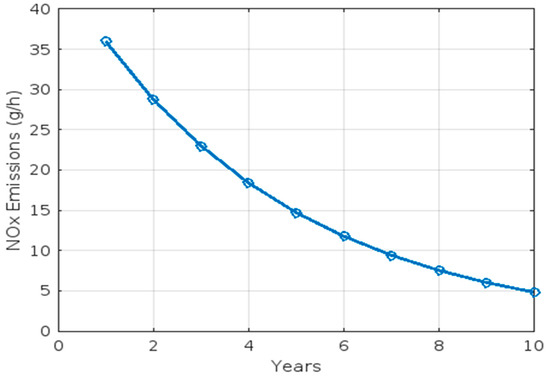
Figure 6.
NOx emissions reduction over time with new TRU technology in Scotland.
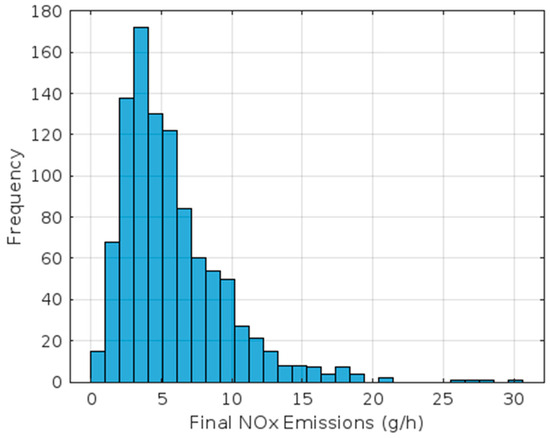
Figure 7.
Monte Carlo simulation of NOx emission reduction after 10 years in Scotland.
Figure 8 shows a direct relationship between TRU operational hours and cumulative emissions. For instance, vehicles running 4200 h per year emitted up to 189,000 g of NOx annually, justifying a strong relationship between extended TRU operation and elevated emission loads, particularly in non-urban routes [12]. Fuel consumption also increased with longer door-open times, rising from 1.7 to 2.0 L/h between 5 and 20 min (Figure 9). The analysis suggests that operational adjustments (e.g., reducing door openings) can lead to fuel savings and a reduction in CO2 emissions. Improving TRU efficiency through operational changes, such as limiting door openings during deliveries, leads to reduced fuel usage and greenhouse gas emissions [10,21].
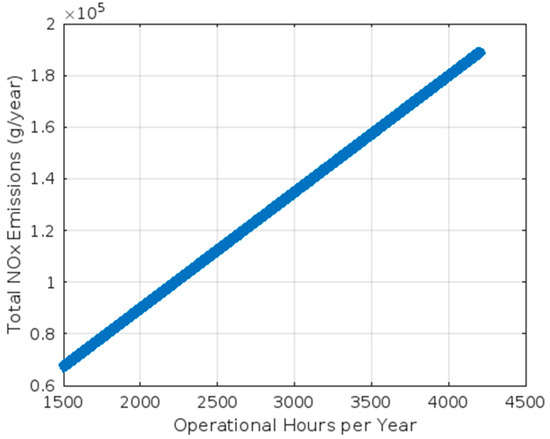
Figure 8.
Annual NOx emissions based on operational hours in Scotland.
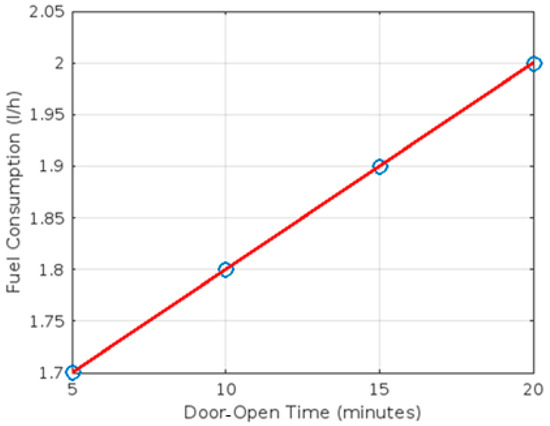
Figure 9.
Fuel consumption vs. door-open time in Scotland.
Figure 10 detailed the costs of retrofitting the TRU fleet to NRMM Stage V standards, between GBP 14M and GBP 21M, resulting in reduced NOx emissions from 45 g/h to 7.5 g/h. The investment in emission control is justified by both public health outcomes and long-term regulatory compliance [18]. The transition to NRMM Stage V standards is crucial for reducing the environmental footprint of non-road mobile machinery like TRUs. Adhering to stringent emission standards results in significant reductions in NOx and particulate emissions [18]. Hagan et al. [26] estimated that the cost of retrofitting fleets is justifiable by the long-term public health benefits and compliance with air quality regulations.
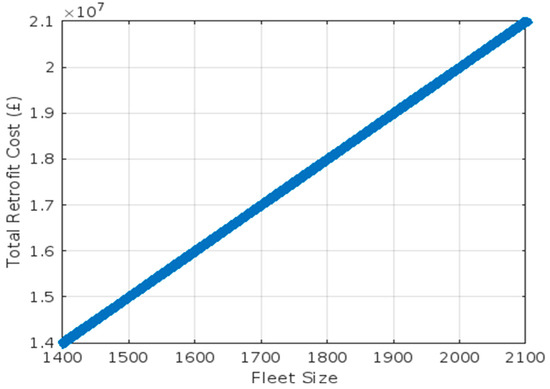
Figure 10.
Total retrofit costs to meet new emission standards in Scotland.
4.3. Cross-Case Analysis
The London and Scotland case studies present contrasting but complementary approaches to lowering emissions in CCL. London emphasises technological adoption (e.g., cryogenic TRUs), routing strategies and behavioural interventions (e.g., door-opening times). In contrast, Scotland prioritises operational hours, retrofitting diesel TRUs and increasing benefit–cost ratio. Both cases highlight the need for context-aware strategies that reflect geographical, economic and policy variation. Table 3 shows the construct mapping of the London and Scotland case studies. This comparison reveals that both regions aim to reduce CCL emissions. However, their strategies are driven by distinct local factors such as urban density, route length and policy emphasis. A combined understanding of technological, operational and regulatory levers is necessary to design effective low-emission logistics systems across diverse contexts.

Table 3.
Construct mapping across London and Scotland case studies.
5. Discussion and Recommendations
The case studies of London and Scotland demonstrate two context-driven strategies to reduce emissions in CCL. London prioritised the integration of advanced TRU technologies and route optimisation, achieving notable reductions in CO2, NOx and PM emissions through cryogenic systems and light-coloured refrigerated bodies. London’s approach underscores the importance of technological innovation and routing efficiency. Optimising delivery routes for low-emissions vehicles can reduce emissions while lowering operational costs [12]. On the other hand, Scotland focuses on emissions from diesel auxiliary TRUs, assessing the operational and economic feasibility of retrofits to meet NRMM Stage V standards. Scotland’s model highlights the emissions impact of prolonged TRU operation and the benefits of simple behavioural adjustments, such as reducing door-opening times during deliveries. These behavioural interventions, while low-tech, can produce measurable energy savings and support temperature stability [27]. These differing approaches align with regional priorities like urban air quality in London and operational resilience in Scotland.
The multi-pollutant modelling used in London aligns with the broader decarbonisation goals set by the UK National Grid ESO [28], supporting more holistic policy frameworks. Scotland’s focus on NOx reductions reflects a public-health-oriented agenda consistent with the WHO’s emphasis on reducing nitrogen dioxide emissions [29,30,31]. The Monte Carlo simulations in both case studies enabled more realistic forecasting by incorporating uncertainties related to operating hours and environmental conditions.
The comparison of regulatory frameworks reveals a gap between on-road and off-road emission standards. Euro VI regulations have driven down emissions for commercial vehicles, while NRMM Stage V standards remain relatively lenient, especially for TRUs [18]. Retrofitting diesel TRUs to meet Stage V standards would require significant investment but could result in substantial reductions in NOx emissions [25]. Aikins and Ramanathan [18] suggested that long-term health benefits and regulatory alignment justified such investments. To achieve national cold chain sustainability goals, the UK must promote the adoption of electric, hybrid and cryogenic TRUs through financial incentives and regulatory support. Cryogenic units, for example, can eliminate NOx and PM emissions while maintaining temperature control [31]. Hybrid diesel–electric systems are practical for rural operations where electric charging infrastructure is limited [15]. In addition, nationwide investment in charging stations, particularly in key urban hubs, will be essential to accelerate adoption.
The real-time monitoring of emissions and temperature data can improve transparency and ensure cold chain integrity. TRUs should be equipped with sensors that track emissions and internal temperatures throughout delivery routes. Integrating blockchain technologies can ensure traceability and regulatory compliance [32]. These systems can help ensure both food safety and carbon accountability. Operational changes such as optimising delivery schedules, using dynamic route planning tools and training drivers on eco-driving practices can further reduce emissions [33,34]. Reducing idling and minimising door-open times helps conserve energy and temperature and reduce fuel use and spoilage risks [35,36,37]. Fleet operators should prioritise these low-cost interventions alongside technological upgrades [36,38].
Finally, the UK government should adopt Euro VII standards for TRUs and phase them in gradually to allow small operators sufficient time and resources to adapt [38]. Financial support for retrofitting and upgrading TRUs must include provisions for maintaining temperature stability during transport [39]. A phased timeline ensures that emissions reductions are achieved without compromising the quality and safety of perishable food [40].
6. Conclusions
This study examined strategies for reducing GHG emissions in CCL, with a focus on real-world case studies from London and Scotland. The findings highlight the potential for significant reductions in CO2, NOx and PM emissions through the adoption of alternative TRU technologies, operational improvements and region-specific strategies. London prioritises innovation through cryogenic systems and optimised routes, while Scotland focuses on retrofitting diesel TRUs and addressing prolonged operational hours. These complementary approaches illustrate that emissions reduction in CCL is not a one-size-fits-all solution but must be tailored to local infrastructure and policy contexts.
The results of this study offer actionable insights for logistics companies and policymakers. For industries, adopting cryogenic or electric TRUs in urban settings can dramatically reduce local pollutants and help comply with tightening emissions regulations. Meanwhile, retrofitting diesel TRUs remains a practical short- to medium-term solution for rural operators. Operational changes such as reducing door-open times, optimising delivery schedules and training drivers in eco-driving practices are low-cost interventions that improve fuel efficiency and help maintain temperature integrity. For policymakers, these findings underscore the need for harmonised regulations across vehicle classes and targeted incentives for sustainable TRU adoption. Nationwide investment in charging infrastructure and subsidies for compliant retrofits are essential for the long-term decarbonisation of the cold chain.
This paper provides a fundamental comparison of regional strategies. Future research should collect primary data through field studies, interviews and direct emissions tracking across diverse logistics settings. Long-term cost–benefit analyses of alternative TRU systems including electric, hybrid and cryogenic models should be expanded to include life cycle emissions and maintenance costs. Furthermore, there is a need to explore the integration of renewable energy sources with TRU operations and to evaluate the role of AI and blockchain in real-time emissions monitoring, compliance and supply chain transparency. These avenues can further support the transition toward a resilient, low-carbon logistics sector.
Author Contributions
Conceptualization, M.M. and S.A.; methodology, M.M. and S.A.; formal analysis, M.M.; data cu-ration, M.M.; writing—original draft preparation, M.M. and S.A.; writing—review and editing, S.A.; visualization, S.A.; supervision, S.A.; project administration, M.M. and S.A. All authors have read and agreed to the published version of the manuscript.
Funding
This research received no external funding.
Data Availability Statement
Data sharing is not applicable to this article as no new data were created or analysed in this study.
Conflicts of Interest
The authors declare no conflicts of interest.
Abbreviations
The following abbreviations are used in this manuscript:
| AI | Artificial Intelligence |
| auxTRUs | Auxiliary Transport Refrigeration Units |
| TRUs | Transport Refrigerated Units |
| CO2 | Carbon Dioxide |
| LD | Linear Dichroism |
| FCC | Food Cold Chain |
| IACO | Improved Ant-Colony Optimisation |
| IGSS-CCL | Intelligent Green Scheduling System for Sustainable Cold Chain Logistics |
| LCA | Life Cycle Assessment |
| LP | Linear Programming |
| LEVs | Low-Emission Vehicles |
| MLR | Multilinear Regression |
| NOx | Nitrogen Oxide |
| NSGA-II | Nondominated Sorting Genetic Algorithm II |
| NRMM | Non-Road Mobile Machinery |
| PM | Particulate Matter |
| QBFO | Quantum Bacterial Foraging Optimisation |
| RFID | Radio Frequency Identification |
| RNN | Recurrent Neural Network |
| RO | Robust Optimisation |
| SFA | Stochastic Frontier Analysis |
| VRP | Vehicle Routing Problem |
References
- Wang, S.; Tao, F.; Shi, Y. Optimization of location–routing problem for cold chain logistics considering carbon footprint. Int. J. Environ. Res. Public Health 2018, 15, 86. [Google Scholar] [CrossRef] [PubMed]
- James, S.J.; James, C. The food cold-chain and climate change. Food Res. Int. 2010, 43, 1944–1956. [Google Scholar] [CrossRef]
- Hsiao, Y.H.; Chen, M.C.; Chin, C.L. Distribution planning for perishable foods in cold chains with quality concerns: Formulation and solution procedure. Trends Food Sci. Technol. 2017, 61, 80–93. [Google Scholar] [CrossRef]
- Jedermann, R.; Ruiz-Garcia, L.; Lang, W. Spatial temperature profiling by semi-passive RFID loggers for perishable food transportation. Comput. Electron. Agric. 2009, 65, 145–154. [Google Scholar] [CrossRef]
- McKinnon, A.C.; Piecyk, M.I. Setting targets for reducing carbon emissions from logistics: Current practice and guiding principles. Carbon Manag. 2012, 3, 629–639. [Google Scholar] [CrossRef]
- Montanari, R. Cold chain tracking: A managerial perspective. Trends Food Sci. Technol. 2008, 19, 425–431. [Google Scholar] [CrossRef]
- Aung, M.M.; Chang, Y.S. Temperature management for the quality assurance of a perishable food supply chain. Food Control 2014, 40, 198–207. [Google Scholar] [CrossRef]
- Woellner, R.A.; Voorhees, J.; Bell, C.L. International Environmental Risk Management: A Systems Approach, 2nd ed.; CRC Press: Boca Raton, FL, USA, 2020. [Google Scholar]
- Bortolini, M.; Faccio, M.; Ferrari, E.; Gamberi, M.; Pilati, F. Fresh food sustainable distribution: Cost, delivery time, and carbon footprint three-objective optimisation. J. Food Eng. 2016, 174, 56–67. [Google Scholar] [CrossRef]
- Webster, J.; Watson, R.T. Analyzing the past to prepare for the future: Writing a literature review. MIS Q. 2002, 26, R13. [Google Scholar]
- Yao, Q.; Zhu, S.; Li, Y. Green vehicle-routing problem of fresh agricultural products considering carbon emission. Int. J. Environ. Res. Public Health 2022, 19, 8675. [Google Scholar] [CrossRef]
- Bai, Q.; Yin, X.; Lim, M.K.; Dong, C. Low-carbon VRP for cold chain logistics considering real-time traffic conditions in the road network. Ind. Manag. Data Syst. 2022, 122, 521–543. [Google Scholar] [CrossRef]
- Liu, B.; Li, J.; Chen, A.; Theodorakis, P.E.; Zhu, Z.; Yu, J. Selection of the cold logistics model based on the carbon footprint of fruits and vegetables in China. J. Clean. Prod. 2022, 334, 130251. [Google Scholar] [CrossRef]
- Shashi; Centobelli, P.; Cerchione, R.; Ertz, M. Food cold chain management: What we know and what we deserve. J. Food Eng. 2021, 291, 110247. [Google Scholar] [CrossRef]
- Shi, Y.; Lin, Y.; Lim, M.K.; Tseng, M.-L.; Tan, C.; Li, Y. An intelligent green scheduling system for sustainable cold chain logistics. Expert Syst. Appl. 2022, 209, 118378. [Google Scholar] [CrossRef]
- Ning, T.; An, L.; Duan, X. Optimization of cold chain distribution path of fresh agricultural products under carbon tax mechanism: A case study in China. J. Intell. Fuzzy Syst. 2021, 40, 10549–10558. [Google Scholar] [CrossRef]
- Feilzer, M.Y. Doing mixed methods research pragmatically: Implications for the rediscovery of pragmatism as a research paradigm. J. Mix. Methods Res. 2010, 4, 6–16. [Google Scholar] [CrossRef]
- Ji, Y.; Du, J.; Wu, X.; Wu, Z.; Qu, D.; Yang, D. Robust optimization approach to two-echelon agricultural cold chain logistics considering carbon emission and stochastic demand. J. Clean. Prod. 2021, 23, 13731–13754. [Google Scholar] [CrossRef]
- Aikins, E.F.; Ramanathan, U. Key factors of carbon footprint in the UK food supply chains: A new perspective of life cycle assessment. Int. J. Oper. Prod. Manag. 2020, 40, 1699–1726. [Google Scholar] [CrossRef]
- Morgan, D.L. Paradigms Lost and Pragmatism Regained: Methodological Implications of Combining Qualitative and Quantitative Methods. J. Mix. Methods Res. 2007, 1, 48–76. [Google Scholar] [CrossRef]
- Hyde, K.F. Recognising deductive processes in qualitative research. Qual. Mark. Res. 2000, 3, 82–89. [Google Scholar] [CrossRef]
- McCarthy, N. Auxiliary Temperature Reduction Units in the Greater London Area. Available online: https://content.tfl.gov.uk/auxiliary-temperature-reduction-units-in-the-greater-london-area.pdf (accessed on 14 June 2024).
- Zemo Partnership. Emissions Testing of Two Auxiliary Transport Refrigeration Units: The Results of a Transport Scotland Funded Project to Measure the Baseline Energy Consumption and Emissions Performance of Two Refrigerated Commercial Vehicles. Available online: https://zemo.org.uk (accessed on 20 September 2024).
- Oliveto, V.J.; Boyd, C.; Smith, D.; Hughes, M.; Borca-Tasciuc, D.A. Luminescent solar concentrators: A review of nanoengineering opportunities for reducing surface losses. IEEE Trans. Nanotechnol. 2022, 21, 360–366. [Google Scholar] [CrossRef]
- Reid, A. Update to the Climate Change Plan—Background Information and Key Issues. SPICe Briefing, Scottish Parliament Information Centre (SPICe). Available online: https://digitalpublications.parliament.scot (accessed on 20 September 2024).
- Hagan, R.; Markey, E.; Clancy, J.; Keating, M.; Donnelly, A.; O’Connor, D.J.; Morrison, L.; McGillicuddy, E.J. Non-Road Mobile Machinery Emissions and Regulations: A Review. Air 2023, 1, 14–36. [Google Scholar] [CrossRef]
- Valerii, M.; Kovalyov, A.; Saiensus, M. Optimization of the cold supply chain logistics network with an environmental dimension. IOP Conf. Ser. Earth Environ. Sci. 2021, 628, 012018. [Google Scholar]
- National Grid ESO. Introducing Our 2020 Future Energy Scenarios. Available online: https://www.neso.energy/news/introducing-our-2020-future-energy-scenarios (accessed on 20 September 2024).
- World Health Organization. WHO Global Air Quality Guidelines. Available online: https://www.who.int/news-room/questions-and-answers/item/who-global-air-quality-guidelines (accessed on 20 September 2024).
- Carslaw, D.C.; Murrells, T.P.; Andersson, J. Have vehicle emissions of primary NO2 peaked? Faraday Discuss. 2016, 189, 439–454. [Google Scholar] [CrossRef] [PubMed]
- Fu, Q.; Li, J.; Chen, H. Resource scheduling method for optimizing the distribution path of fresh agricultural products under low-carbon environmental constraints. Sci. Program. 2022, 23, 7692135. [Google Scholar] [CrossRef]
- Seixas, J.; Simões, S.; Dias, L.; Kanudia, A.; Fortes, P.; Gargiulo, M. Assessing the cost-effectiveness of electric vehicles in European countries using integrated modelling. Energy Policy 2015, 80, 165–176. [Google Scholar] [CrossRef]
- Kouhizadeh, M.; Sarkis, J. Blockchain Practices, Potentials, and Perspectives in Greening Supply Chains. Sustainability 2018, 10, 3652. [Google Scholar] [CrossRef]
- Li, Y.; Lim, M.K.; Tseng, M.-L. A green vehicle routing model based on modified particle swarm optimization for cold chain logistics. Ind. Manag. Data Syst. 2019, 119, 473–494. [Google Scholar] [CrossRef]
- Zhao, B.; Gui, H.; Li, H.; Xue, J. Cold Chain Logistics Path Optimization via Improved Multi-Objective Ant Colony Algorithm. IEEE Access 2020, 8, 142977–142995. [Google Scholar] [CrossRef]
- Wu, J.; Li, Q.; Liu, G.; Xie, R.; Zou, Y.; Scipioni, A.; Manzardo, A. Evaluating the impact of refrigerated transport trucks in China on climate change from the life cycle perspective. Environ. Impact Assess. Rev. 2022, 97, 106866. [Google Scholar] [CrossRef]
- Liu, P.; Wang, S. Evolutionary Game Analysis of Cold Chain Logistics Outsourcing of Fresh Food Enterprises with Operating Risks. IEEE Access 2020, 8, 127095. [Google Scholar] [CrossRef]
- Ricardo Energy & Environment. Determining the Environmental Impacts of Conventional and Alternatively Fuelled Vehicles Through LCA. Contract Ref. 34027703/2018/782375/ETU/CLIMA.C.4, 13 July. Available online: https://climate.ec.europa.eu/system/files/2020-09/2020_study_main_report_en.pdf (accessed on 20 September 2024).
- Meneghetti, A.; Dal Magro, F.; Romagnoli, A. Renewable energy penetration in food delivery: Coupling photovoltaics with transport refrigerated units. Energy 2021, 232, 120994. [Google Scholar] [CrossRef]
- Wang, X.; Xia, J.; Zou, J.; Huang, W.; Matetic, M.B.; Bakarić, M.; Zhang, X. Pathways toward precise monitoring and low-carbon sustainability in fruit cold chain logistics: A solution enabled by flexible temperature sensing. Mater. Today Sustain. 2023, 24, 100592. [Google Scholar] [CrossRef]
Disclaimer/Publisher’s Note: The statements, opinions and data contained in all publications are solely those of the individual author(s) and contributor(s) and not of MDPI and/or the editor(s). MDPI and/or the editor(s) disclaim responsibility for any injury to people or property resulting from any ideas, methods, instructions or products referred to in the content. |
© 2025 by the authors. Licensee MDPI, Basel, Switzerland. This article is an open access article distributed under the terms and conditions of the Creative Commons Attribution (CC BY) license (https://creativecommons.org/licenses/by/4.0/).

